Brassica oleracea var. acephala ‘Lacinato’
Dinosaur kale, also known as Tuscan or Lacinato kale, is without a doubt my favorite type.
Its long, narrow leaves make it such a breeze to cook with. And in my opinion, it is one of the most ornamental edible plants there is.
Dinosaur kale is easy to grow, and like other kale varieties, it is considered a nutritional powerhouse. I think we should treat it like a garden staple – dino kale for every garden!
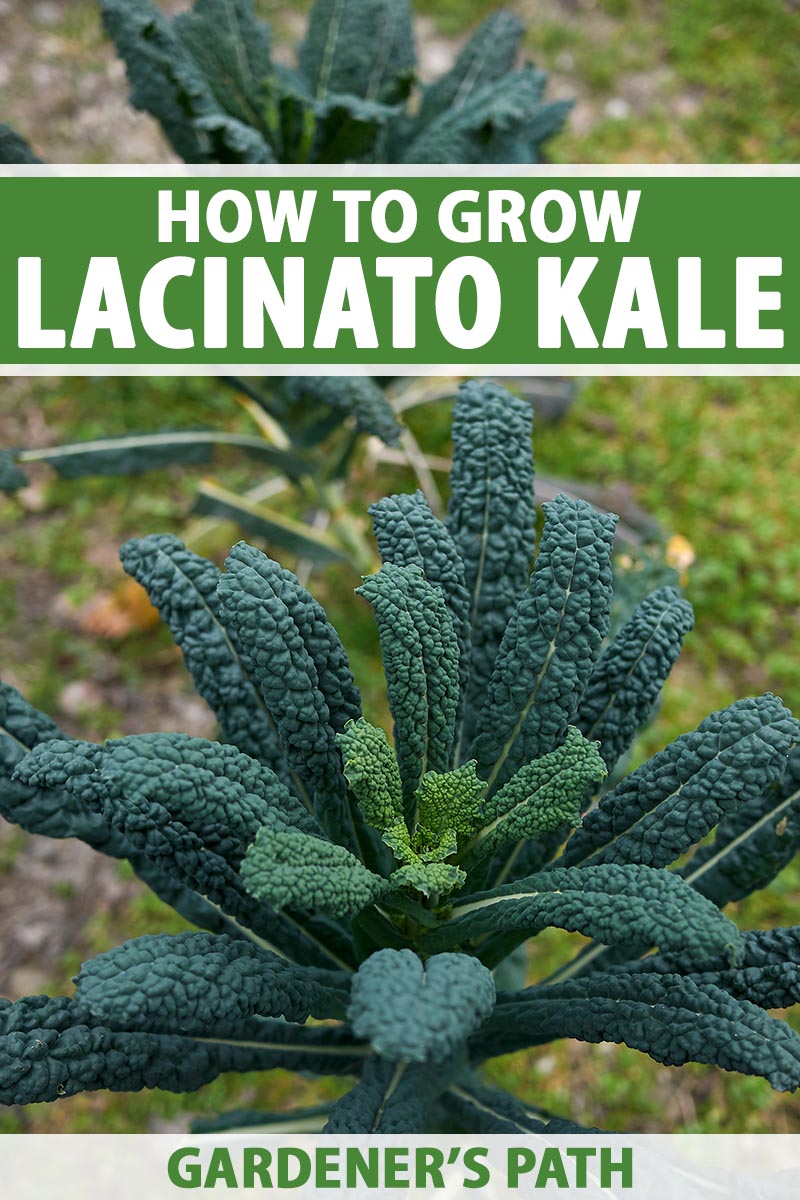
We link to vendors to help you find relevant products. If you buy from one of our links, we may earn a commission.
I’m going to guide you through the growing process for this leafy green, and recommend a few of my favorite cultivars. I’ll even tempt your taste buds with some preserving and cooking ideas.
Here’s an overview of what I’ll cover:
What You’ll Learn
What Is Lacinato Kale?
This garden beast goes by many names. Some call it Lacinato, others call it Italian or Tuscan kale.

Lacinato originated in and has long been cultivated in Italy. It is particularly popular in the Tuscany region, and some of its common names reflect this – Toscano, Nero di Toscano, Tuscan kale, or black Tuscan.
Also known to the Italians as cavolo nero, which means “black cabbage,” dinosaur kale is an heirloom cultivar so beloved that it has also been used as a parent to create new varieties. As such, similar to the Roma tomato, this name is now used to denote a whole category of kale cultivars beyond the original.
In other words, in addition to the standard ‘Lacinato’ variety, there are additional Lacinato-type cultivars available today as well. (I’ll get to those a little later in the article, so keep reading!)
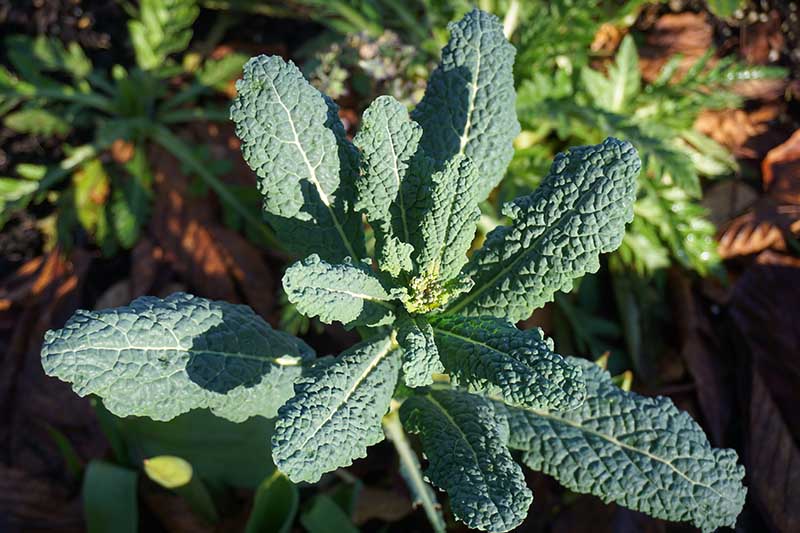
Like all varieties of kale, Lacinato is a brassica, or member of the mustard or Brassicaceae family, with many edible relatives including broccoli, daikon, and bok choy.
It has long, strap-shaped foliage that is dark blue-green in color, and it is frequently called “dinosaur kale” because of the bumpy, savoyed texture of its leaves, reminiscent of reptile skin.
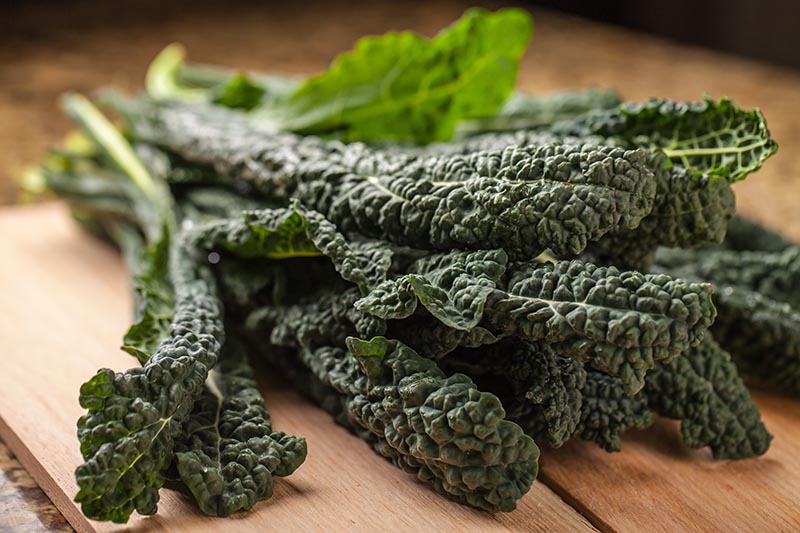
Lacinato plants have an upright habit, usually growing two or up to three feet tall. Their leaves can grow to be one to two feet long, and two to four inches wide.
When leaves are harvested from the bottom of these plants, they take on a palm tree-like appearance as they grow, which account for another of its common names, “palm kale.”

Grown for its leafy greens, because of Lacinato’s upright growth habit, harvesting is easy.
Compared to some of the curlier varieties, Lacinato is extremely easy to clean and inspect for pests before preparing it for cooking – thus winning its special place in my heart, and in my garden.
Another advantage of this “black cabbage” is that it holds up to summer heat in the garden better than some other types.
It is also one of the best types of kale to grow for cold climates.
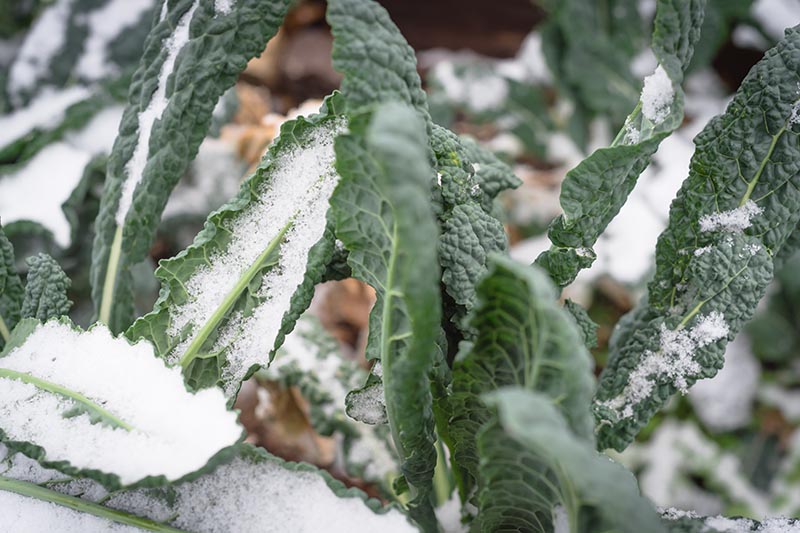
Dinosaur kale is a biennial, meaning it flowers and sets seed in its second year.
And I would be remiss if I didn’t draw attention to the highly ornamental value of this edible plant.
Lacinato’s dark blueish-green color is gorgeous when paired with flowers, and this veggie can serve as an elegant backdrop in a flower bed.
It would be particularly beautiful in an autumn garden, planted among colorful ornamental varieties of kale and chrysanthemums.
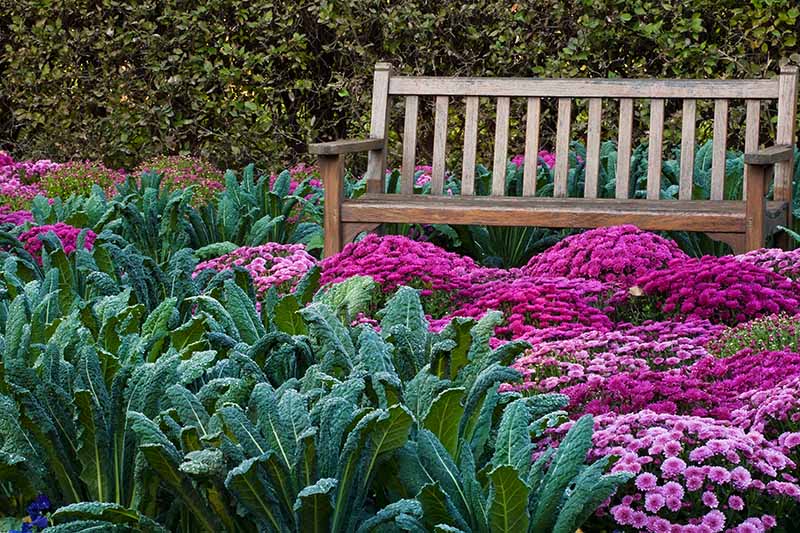
And even if your gardening efforts are more focused on growing food than on ornamental landscaping, a little added beauty is always welcome in the garden.
Like other cultivars of this leafy green, Lacinato is considered a highly nutritious superfood, whether you eat it raw or cooked.
With so much going for it, it would be a shame to miss out on the opportunity to have a ready supply growing in your backyard.
Ready to learn the specifics of growing this garden champion? Let’s go!
How to Grow
Easily grown from seed, Lacinato is propagated just like other types of kale. For complete growing guidance, make sure to refer to our kale growing guide.
In the meantime, I’ll provide you with some of the basics for growing this beautiful garden vegetable at home.
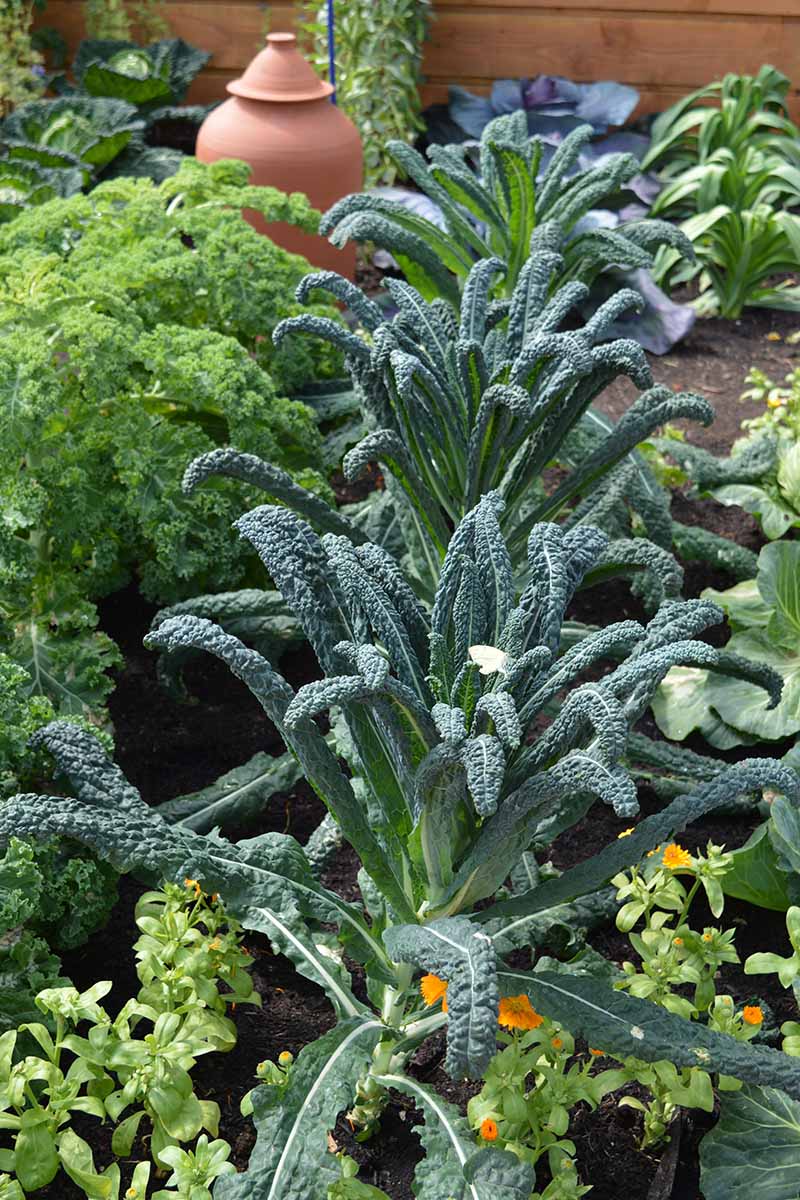
This brassica is a cool season crop, so it’s best to sow seeds in spring or fall. The precise time to sow these seeds will vary depending on your climate. You can learn more about the best time to sow kale in our article.
As a general rule, you can direct sow this leafy green one or two weeks before your last spring frost, or ten to twelve weeks before your first fall frost.
Or, if you prefer, you can also start seedlings indoors about six weeks before you want to transplant them. Make sure you set out your transplants before the weather heats up in the spring, and be sure to harden them off gradually before planting out.

If you are growing transplants for setting out in autumn, check out our guide on when to plant crops in fall.
Lacinato should be grown in full or part sun, and in well-drained soil amended with organic matter such as compost.
If container gardening is your vibe, you can grow this type of kale in containers.
Lacinato can also be grown in raised beds, where it will be particularly happy when situated among some of its favorite companion plants.

This garden veggie needs about one inch of water a week – but you’ll need to increase watering during periods of hot weather. In my garden in arid northeast Utah, I water my crop every day during the hottest part of the summer to keep it happy.
If you want to save seeds from your plants to grow in subsequent years, let them overwinter and collect their seeds after flowering in the second year of growth. You can consult our guide on saving kale seeds for more information.
Now that you’ve got the basics of growing these plants down, are you ready to check out some cultivars?
Cultivars to Select
As I mentioned above, new crosses of Lacinato with other types of kale have been hybridized for home growers, and this category provides many delicious options.
Black Magic
‘Black Magic’ is an improved dinosaur-type kale. It has long, narrow leaves that are a dark blue-green color and deeply savoyed. It has an even milder flavor than the standard ‘Lacinato’ variety.
‘Black Magic’ is cold tolerant and has good bolt-resistance.
‘Black Magic’ plants grow to 24-36 inches tall and have a spread of 12-24 inches. The leaves are a bit wider than the standard ‘Lacinato’ variety. You can expect a harvest of mature leaves in 65-80 days.
You can find ‘Black Magic’ seeds for purchase in packets of 500 available from Burpee.
Dazzling Blue
‘Dazzling Blue’ has gorgeous blue-green leaves with pinkish-purple midribs.
This hybrid cultivar is a cross between ‘Lacinato’ and ‘Rainbow Lacinato,’ which itself is a cross between ‘Lacinato’ and ‘Redbor,’ a purple-colored kale.
Thanks to its ‘Redbor’ genes, this cultivar is even more cold-hardy than other dinosaur-type varieties.
Plants reach 24-26 inches tall and 24-30 inches wide at maturity. For full sized leaves, harvest starts at around 60 days.
You can find ‘Dazzling Blue’ seeds in packets of 500 available at Burpee.
Lacinato
‘Lacinato’ is the original Tuscan-type kale. Its signature strap-shaped foliage is dark blue-green with white midribs.
Plant ‘Lacinato’ and you’ll be growing part of agricultural history – this variety dates back to at least the 1700s and was grown in Thomas Jefferson’s garden at Monticello.
Plants grow to two or three feet tall and have leaves that can reach two feet long. This cultivar provides full-sized leaves ready for harvest in 65-80 days.
You’ll find conventionally grown ‘Lacinato’ seeds in a variety of packet sizes at True Leaf Market.
Or if you prefer to grow organically, True Leaf Market carries certified organic ‘Lacinato’ seeds as well.
Managing Pests and Disease
Lacinato is delicious – so can you blame the critters who want to make it their lunch, too?
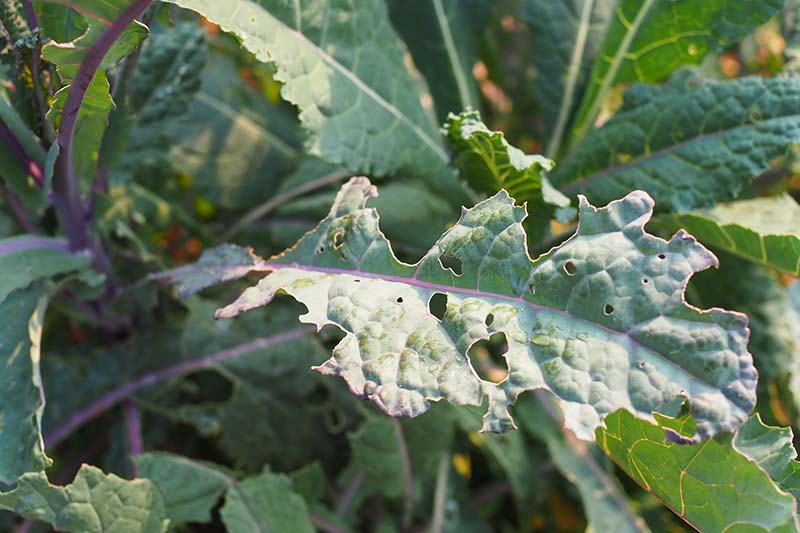
Like other brassicas, cavolo nero is often visited (and sometimes devoured) by cabbage worms, cabbage loopers, beet armyworms, grasshoppers, and aphids, among other pests.
Aphids can be identified by looking closely at the undersides of leaves for telltale little green or gray spots, which on closer inspection have legs and are busy sucking nutrients out of your crop.
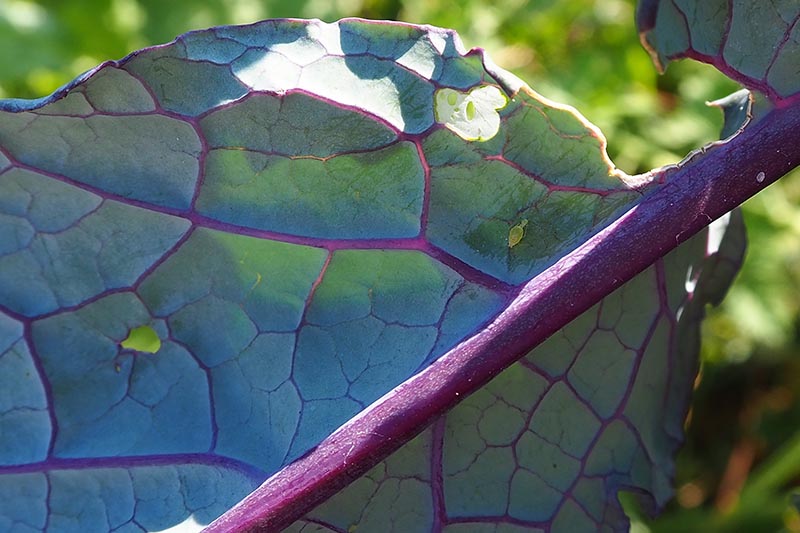
I find the best way to protect my kale from pests organically is by keeping weeds down around my plants, inspecting my plants regularly, and removing pests by hand. Small populations of aphids can be removed with a strong jet of water from your hose.
Pest populations in my garden are also kept under control with the help of predatory insects like praying mantises, spiders, and wasps. I give them a welcoming home by avoiding the use of pesticides, and planting cosmos, dill, and cilantro nearby to provide habitat and forage for these beneficial insects.
To learn more about protecting this cole crop from pests and diseases, make sure to read our guide.
Harvesting
You can harvest cavolo nero when its leaves are small for baby greens, approximately 25-30 days after sowing.
Or allow the foliage to mature and grow to full size and start harvesting about 60-80 days after you put your seeds in the soil.
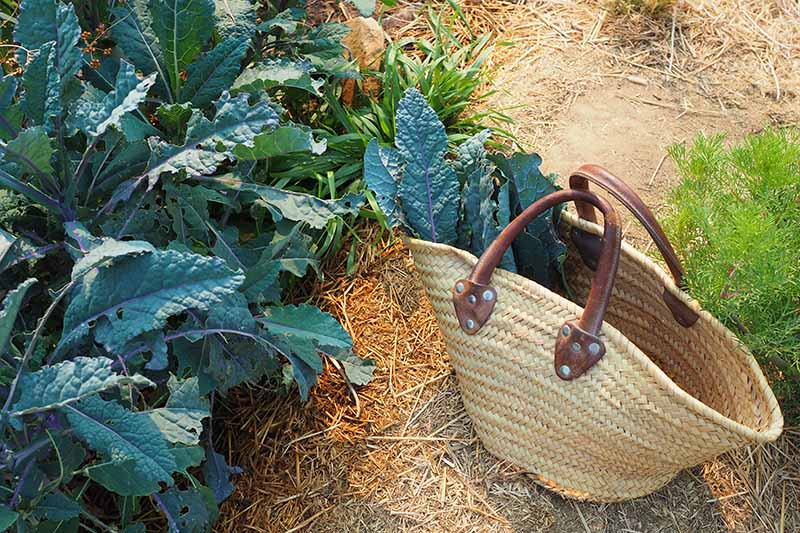
To make sure you pick your Lacinato properly and from the right part of the plant, you may want to take a gander at our helpful guide to harvesting kale.
Or if you prefer the “Cliff’s Notes” version, I’ll give it to you here – harvest the largest bottom leaves first, rather than the topmost inner leaves.

This will encourage your crop to keep producing more leafy greens, and will give your plants that palm tree appearance this brassica is known for.
Preserving
While this crop can be left to overwinter in many USDA Hardiness Zones, you can also preserve its long, nutritious leaves for eating over the winter months by freezing, dehydrating, or fermenting them.
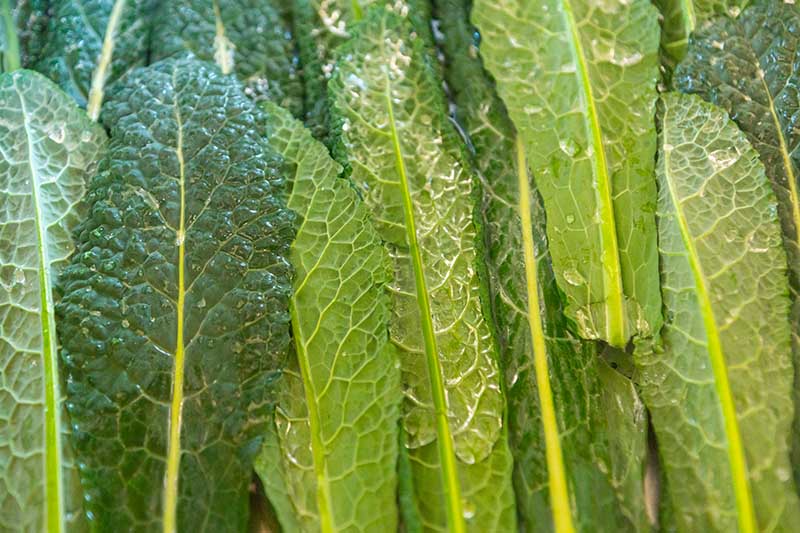
Before proceeding with any of the following preservation methods, you will want to thoroughly clean the leaves and stems.
Freezing
Lacinato can be frozen, but it keeps its flavor best if blanched or otherwise cooked first.
That’s because enzymes present on raw produce remain active after freezing, and will alter the flavor or texture of raw frozen produce.
To prepare this vegetable for freezing by blanching it, first remove the stems and large midribs if you don’t like eating them, then chop the cleaned leaves into smaller strips.

Bring a large pot of water to boil, then blanch in small batches. Suzanne Driessen, Extension educator at University of Minnesota Extension, recommends blanching four cups of packed greens at a time per gallon of water.
Once you put the Lacinato in the pot of boiling water, wait until it starts boiling again, then start your timer for two minutes. When the time is up, transfer the greens into an ice water bath for two minutes.
Spin the leaves dry in a salad spinner or pat them dry between two clean kitchen towels, then store in a freezer container or zip top bags.
If you do choose to freeze your raw leaves without blanching them first, try to use them within four to six weeks for the best flavor.
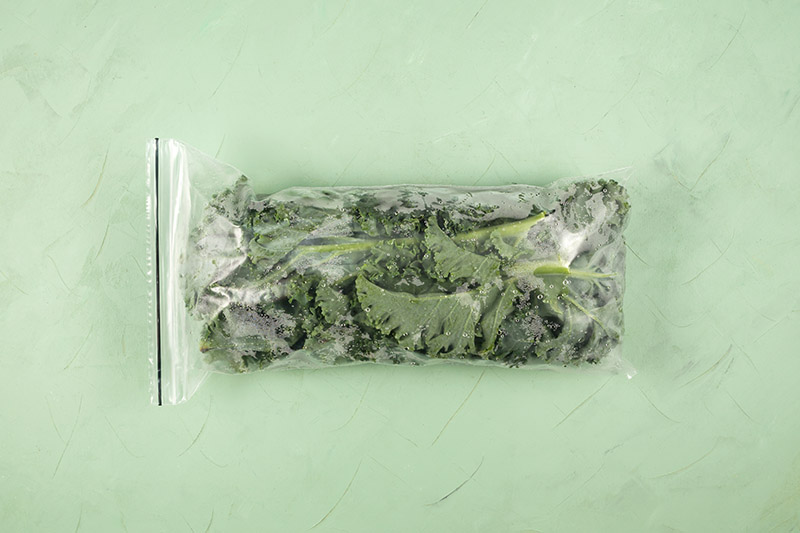
Another option for freezing your harvest is to simply cook it in whatever way you most enjoy eating it, and then freeze it. Whenever I freeze mine, it’s almost always sauteed with a little olive oil and garlic.
However you freeze these leafy greens, make sure to label them with the date. Cooked or blanched greens can be stored in the freezer for up to eight months.
Dehydrating
If you tend to run out of room for storing your garden’s bounty in your freezer like I do, a good backup plan is dehydration.
Like many other garden veggies, Lacinato can be dried in an oven set at a low temperature, or in a food dehydrator. Refer to the instructions on your dehydrator for heat and time recommendations.
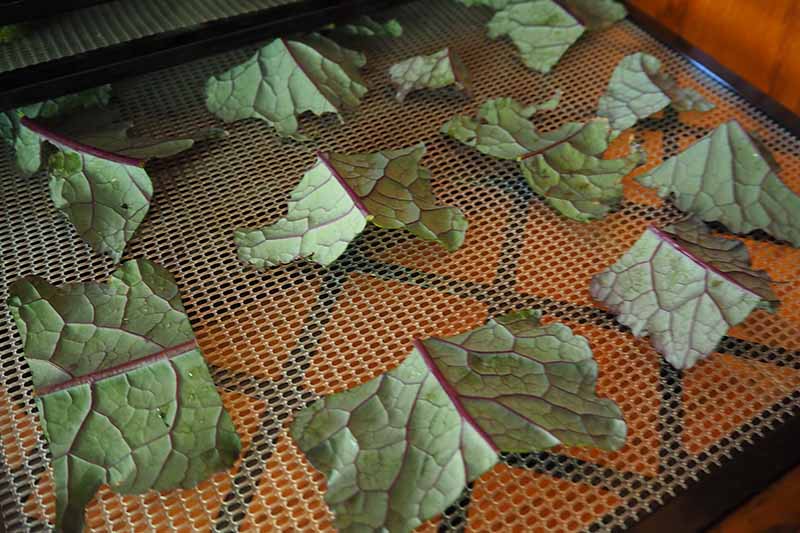
Instead of dehydrating this leafy green plain, you could turn it into some tasty kale chips instead – there’s a recipe on our sister site, Foodal.
Fermenting
Another good way to preserve extra garden produce like dinosaur kale is to transform it into probiotic-rich lacto-fermented pickles.
This process is much easier and safer than canning since your veggies are preserved in an acidic brine. The bacteria that cause botulism cannot survive in acidic brines, and there’s no need to pull out your pressure canner.
I like to include Lacinato in many of my fermented vegetable preparations, such as my lacto-fermented turnip and beet pickles.
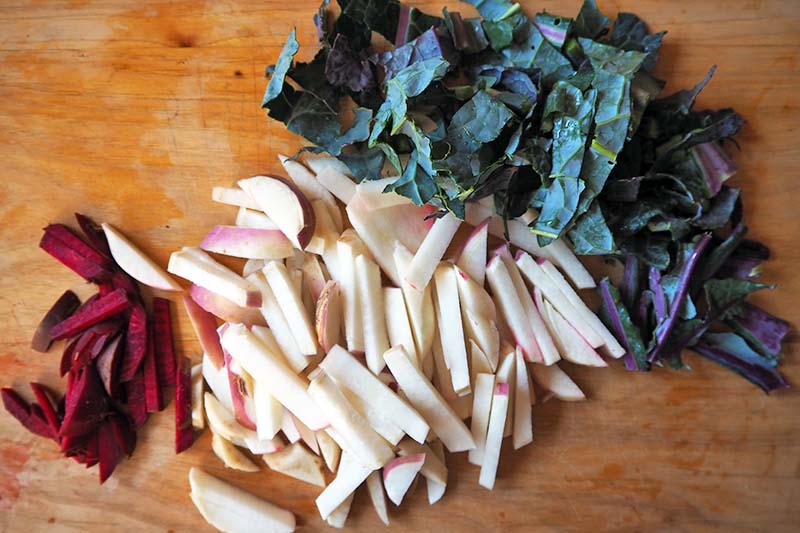
Making these pickles is easy and doesn’t require any special equipment.
Simply chop your veggies, place them in a clean jar, and add salt and chlorine-free water. I recommend approximately 1 tablespoon of sea salt for a pint jar, which will give you a 3 percent solution. This is enough salt to keep your ferment slow and steady and prevent any pathogenic bacteria from growing.
Try to keep the veggies submerged in the solution while they are fermenting, you can use a pickle weight for this purpose, before putting the lid on. Or if there are small pieces of veggies in your jar that keep floating to the top, simply stir the surface of the brine daily to prevent mold from growing there.
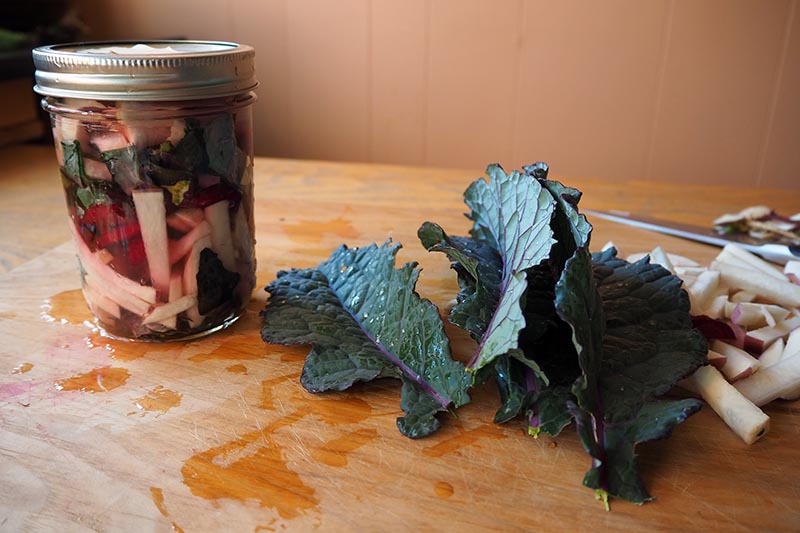
Place your jar of fermenting veggies out of direct sunlight, but somewhere that you will see it and remember to check on it. Put the lid on but don’t tighten it, to allow for pressure to be released as it builds up during fermentation.
It’s also a good idea to put the jar on a plate to collect the overflowing brine that inevitably occurs when bacteria and yeasts become active.
Let the veggies ferment for approximately one week or so, and taste them to determine if they are ready. They should taste like sour pickles when they are ready to eat.
These will keep in the fridge nearly indefinitely, if you don’t contaminate them – with a utensil that has been in your mouth, for instance, – and as long as the veggies remain submerged in the brine.
After long periods of storage, eventually the veggies will soften, becoming less pickle-like. I have a few jars of fermented veggies that have been in my fridge for over two years!
You could also add some chopped leaves or stems of this cruciferous veggie to a jar of lacto-fermented dill pickles. There’s a recipe at our sister site Foodal.
Recipes and Cooking Ideas
Lacinato can be used like any other type of kale, but, as I mentioned earlier, I find it much easier to prepare from the garden than other cultivars. It doesn’t have frilly leaf margins where bugs and dirt can hide.
When washing this veggie, I like to fill my salad spinner with water and plunge the leaves into it. I drain the water and repeat until the washing water is clear. I also inspect the undersides of leaves for any pests that may have hitchhiked in from the garden.
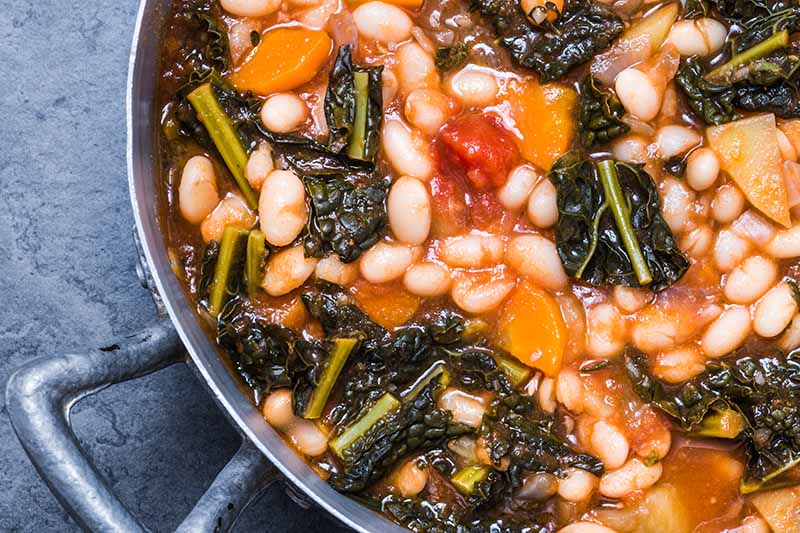
This leafy green can go into smoothies, salads, sautes, casseroles, or soups. In fact, Lacinato is one of the traditional ingredients in Italian minestrone.
One of my favorite ways to use raw Lacinato is to transform it into a pesto. I usually have a much larger quantity of these leafy greens in my garden than I do basil, so this substitution allows me to enjoy this tasty Italian sauce even when I don’t have enough basil on hand.
If you’d like to try making your own, there’s a recipe for kale almond pesto on our sister site, Foodal.

And when you have this pesto at the ready, there’s no end of ways to use it – on toast, drizzled over a plate of homegrown tomatoes and fresh mozzarella cheese, or of course, on pasta.
Speaking of pasta, you might also enjoy this recipe from Foodal for butternut squash and kale pasta salad, in which Lacinato marries beautifully with hearty winter squash for a warming autumnal meal.

If that sounds tasty but you’re in the mood for something with a different flavor profile, why not try this recipe for spicy peanut kale with shoestring potato fries? You’ll find this one on Foodal as well.
Quick Reference Growing Guide
| Plant Type: | Biennial leafy green vegetable | Maintenance: | Low |
| Native to: | The Mediterranean and Asia Minor | Tolerance: | Heavy frost |
| Hardiness (USDA Zone): | 2-11 | Soil Type: | Organically rich loam |
| Season: | Cool season (spring/fall) | Soil pH: | 5.6-7.0 |
| Exposure: | Full sun, part shade | Soil Drainage: | Well-draining |
| Time to Maturity: | 60-85 days | Companion Planting: | Beans, buckwheat, bunching onions, chives, cilantro, dill, garlic, hairy vetch, hot peppers, leeks, lemongrass, marigolds, nasturtiums, shallots, sorghum, sweet alyssum, tomatoes |
| Spacing: | 12 inches | Avoid Planting With: | Black walnut, sunflower, tree of heaven |
| Planting Depth: | 1/4 inch (seeds) | Family: | Brassicaceae |
| Height: | 24-36 inches | Genus: | Brassica |
| Spread: | 12-30 inches | Species: | oleracea |
| Water Needs: | Moderate | Variety: | acephala |
| Common Pests: | Aphids, beet armyworms, cabbage root maggots, cabbage loopers, cabbage worms, cutworms, diamondback moths, flea beetles, root knot nematodes, slugs, snails, thrips | Common Diseases: | Alternaria leaf spot, anthracnose, black rot, club root, damping off, downy mildew |
Grow Your Own Garden Dino-mite
If you’re ready to grow this leafy green in your garden, remember to give it time to become established in spring or fall, provide it with full sun or part shade, and offer it more water if the weather is warm.
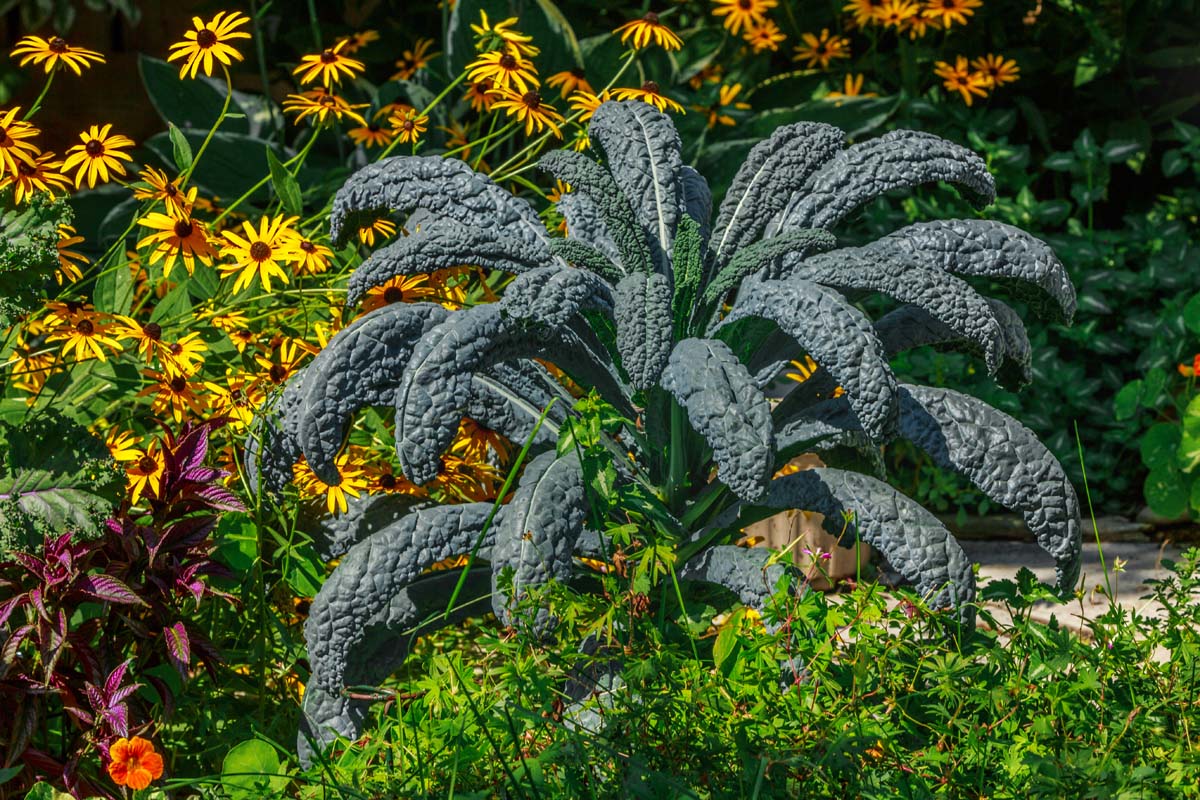
I’m a huge Lacinato fan. I admire this vegetable for its striking shape in my garden, and I’m thankful that it’s so easy to grow, and tasty in my cooking.
What do you love about dinosaur kale? Let me know in the comments.
Ready to learn about growing other types of kale? Get started here:
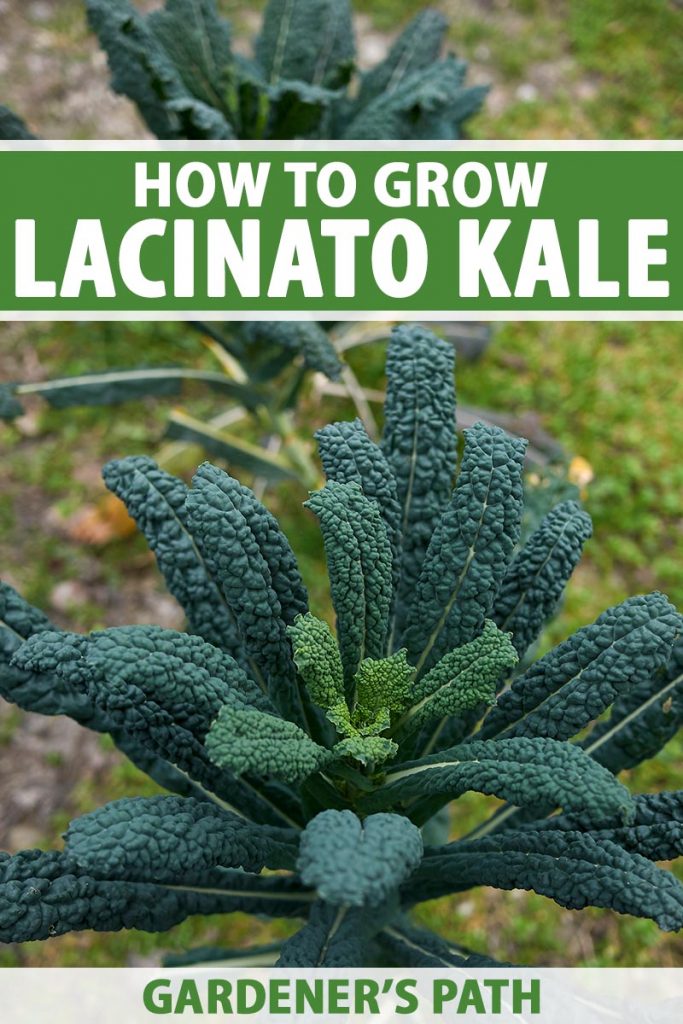
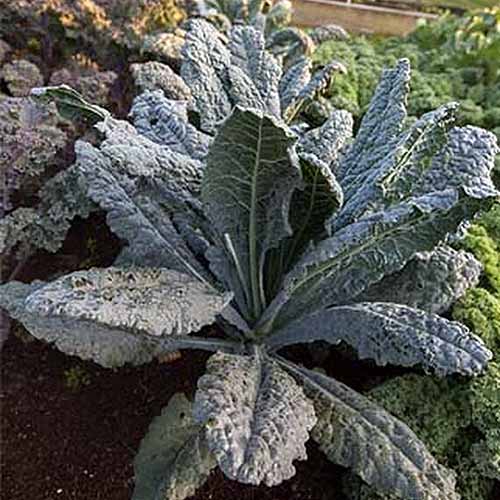
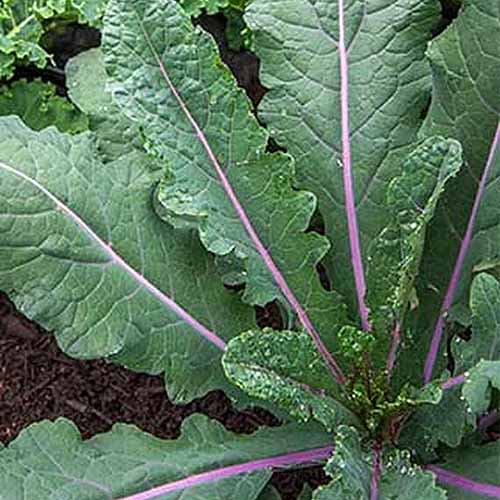
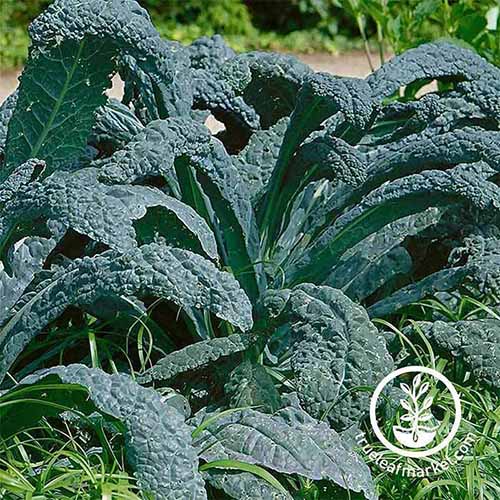
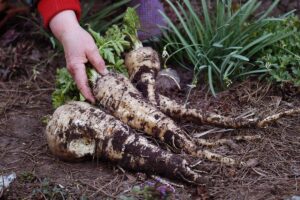


This was an extremely well written and informative article. I thoroughly enjoyed it. I’m excited about doing some of the ferments, because I didn’t realize you could ferment kale. However, I did have one question, if I don’t want to save seeds, and I want to keep the plant growing after 2 years is that possible? If I cut off the top where it’s beginning to flower will that stop the bolting flowering process and allow it to continue Leaf production? Or, should I just allow it to go ahead and flower and save the seeds?. I’m assuming that if… Read more »
Hi Suzanne, I’m so glad you enjoyed the article – I appreciate your feedback! Officially, kale is a biennial (meaning it only lives 2 years) but I have had kale plants live for more than two years myself. If you want to give this a try, just cut off the flowering stalks as soon as you notice them. Your climate can also effect the success of this. When I had my “perennial” kale growing, it was in a fairly shady location, so wasn’t being exposed to the hottest sun of summer. Kale is a cool season plant and really intense… Read more »
Very interesting article and I plan to save it so I can do some more reading. I am interested in growing the Lacinato Kale because I have some geese and they have eaten all the grass in the fenced area. I have been buying large bags of Kale at the grocery. It works very well until the grass comes back in the spring. I am going to get some of the Lacinato seed and hope we can get it in the ground and have it growing. Since it is a biennial I hope to have it growing in the fall… Read more »
Hi Jan,
Thanks for taking the time to leave a comment.
Growing kale for your geese sounds like a fun project. I hope you’ll hop back on here and share some photos if you get the chance – we’d love to see your geese enjoying their kale!
And thanks for the cleaning tip for leafy greens – I’m sure our readers will appreciate this!
Are there any kale varieties that are similar to dinosaur kale that can live for basically forever? Thanks for your help!
Hi Alison,
There are some perennial kales such as purple tree collards, but I haven’t come across any that have lacinato-like leaves and are perennial. Plus, it would depend on your hardiness zone whether the perennial ones are actually perennial or not.
Please let me know if you find any that fits what you’re looking for – I’d love to know!
Best of luck!